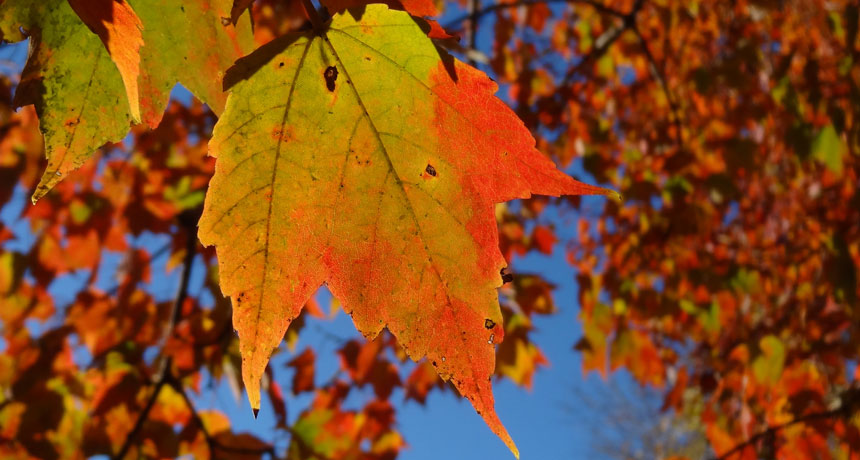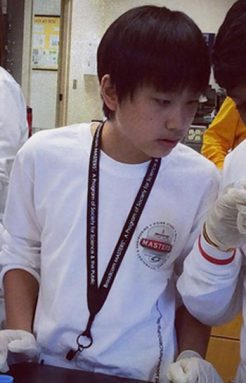A teen turns an autumn chore into a science project
Bryant Liu tried to break down his lawn litter into sugars for fuel

These autumn leaves might look like a chore to rake. But one teen used fallen leaves into a science project aimed at making a biofuel.
Martin LaBar/Flickr/ (CC BY-NC 2.0)
SAN JOSE, Calif. — It’s fall in the Northern Hemisphere, and that means some trees are losing their leaves. Many people might see all that yard waste as a chore to be cleaned up. But Bryant Liu, 13, looked at his leaf-blanketed lawn and saw a potential source of energy.
The freshman at Rocky Point High School in Rocky Point, N.Y., showed off his eighth grade science fair project at a competition here called Broadcom MASTERS (for Math, Applied Science, Technology and Engineering for Rising Stars). This program is sponsored by Broadcom, a company that builds devices to help computers connect to the Internet. Broadcom MASTERS was created by Society for Science & the Public and brings 30 students from across the United States together every year to present their middle-school research to each other and the public.
Right now, most people fuel their cars with gasoline made from fossil fuels such as petroleum. Fossil fuels come from the decayed remains of organisms that died many millions of years ago. But eventually, there won’t be any more fossil fuels to draw upon. So scientists are making biofuels— fuels based on the carbon stored in living organisms, such as plants. Such fuels are more renewable than fossil fuels because plants such as corn and sugarcane can be grown again and again. For instance, engineers can produce bioethanol— a type of alcohol fuel — from the sugars in these plants.
Sugarcane and corn have lots of sugar that is easy to ferment, meaning convert into alcohol. Turning to dead leaves instead presents a challenge for biofuel developers. Dead leaves have sugar, but they also have lots of lignin — a tough substance that strengthens the walls of plant cells. To get to the sugars inside, scientists first have to break down the lignin with chemicals. And that’s a potentially expensive process.

The young researcher gathered up three garbage bags full of oak leaves from his yard. Then he went to his father’s laboratory at the Brookhaven National Laboratory in Upton, N.Y. He ground up the dead leaves, and then carefully loaded equal amounts of this debris into test tubes. Afterward, he added an acid solution to the test tubes at concentrations of 0.25 percent, 0.5 percent or 1 percent. Other test tubes got a 0.5 percent, 1 percent or 2 percent solution of some base.
A third and final set of test tubes got no pretreatment. It served as a control — a part of the experiment with no change. This was Bryant’s favorite part. “I thought that was really fun,” he says. “It made me feel like a real scientist.”
Most test tubes in each group were heated — to 50° Celsius (122° Fahrenheit), 70 °C (158 °F) or 120 °C (248 °F). But for each group he also had a set of unheated controls.
Finally, Bryant added cellulase to all his tubes. This is an enzyme — a molecule that helps chemical reactions happen. Cellulase breaks down cellulose, a fiber in plant cell walls, into simple sugars. He then measured the sugar levels.
The teen found that pretreating leaves with either an acid or base boosted the release of sugar from his yard’s leaves.
He now concludes that either pre-treatment could help scientists get more sugar — and energy — out of plant materials, such as fall yard wastes. Right now, he explains, the process is still too expensive, but he hopes to find a way to cut the cost.
Bryant now wants to take the sugars from his finding to the next step — making ethanol — “and see how much I can produce from the leaves I collect.” If he could create a better method for producing biofuel, he explains, people would need fewer fossils fuels and “have a renewable energy source for the future.” And, Bryant adds, if people use all those dead leaves for biofuel, he and other kids may have to do less raking each fall.
Follow Eureka! Lab on Twitter
Power Words
(for more about Power Words, click here)
acid A chemical that increases the level of hydrogen ions in a solution.
acidic An adjective for materials that contain acid. These materials often are capable of eating away at some minerals such as carbonate, or preventing their formation in the first place.
base (in chemistry) A chemical that produces hydroxide ions (OH-) in a solution. Basic solutions are also referred to as alkaline. (in genetics) A shortened version of the term nucleobase. These bases are building blocks of DNA and RNA molecules.
bioethanol An alcohol derived from crops such as corn or sugar cane that can be used as a fuel. Researchers therefore refer to it as a type of biofuel.
biofuels Energy sources derived from carbon stored in living organisms. Although wood is a biofuel, most people who support “green” sources of energy consider biofuels to be liquids that can substitute for gasoline. Examples include bioethanol, an alcohol derived from crops such as corn or sugar cane. Engineers are also developing ways to make biofuels from nonfood crops, such as trees and shrubs. Renewable biofuels are an alternative to nonrenewable fossil fuels.
cellulase An enzyme that breaks down cellulose into sugar (glucose) molecules.
cellulose A type of fiber found in plant cell walls. It is formed by chains of glucose molecules.
control A part of an experiment where there is no change from normal conditions. The control is essential to scientific experiments. It shows that any new effect is likely due only to the part of the test that a researcher has altered. For example, if scientists were testing different types of fertilizer in a garden, they would want one section of it to remain unfertilized, as the control. Its area would show how plants in this garden grow under normal conditions. And that give scientists something against which they can compare their experimental data.
enzymes Molecules made by living things to speed up chemical reactions.
fermentation The metabolic process of converting carbohydrates (sugars and starches) into short-chain fatty acids, gases or alcohol. Yeast and bacteria are central to the process of fermentation. Fermentation is a process used to liberate nutrients from food in the human gut. It also is an underlying process used to make alcoholic beverages, from wine and beer to stronger spirits.
fossil fuel Any fuel — such as coal, petroleum (crude oil) or natural gas — that has developed in the Earth over millions of years from the decayed remains of bacteria, plants or animals.
lignin A natural substance that helps strengthen the cell walls of plants. Although lignin is made from a large number of sugar molecules, which should provide energy, livestock can’t digest this material because of the way its sugars are chemically bonded together.
petroleum A thick flammable liquid mixture of hydrocarbons. Petroleum is a fossil fuel mainly found beneath the Earth’s surface. It is the source of the chemicals used to make gasoline, lubricating oils, plastics and many other products.
renewable energy Energy from a source that is not depleted by use, such as hydropower (water), wind power or solar power.







